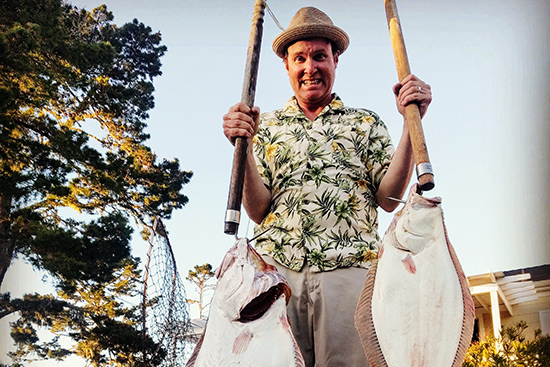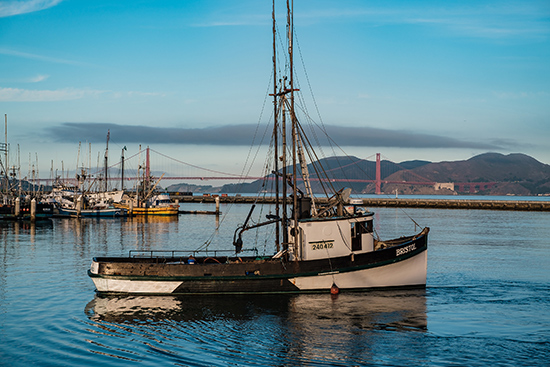气候变化重创加州餐饮行业,可持续的海鲜在哪里?

|
“加州已经不正常了。”位于旧金山海边的海鲜餐馆和批发商Two X Sea的老板肯尼·贝洛夫说。他说的不是加州山火蔓延,还有房价高企,当然也都是事实。他说的是加州鱼类的问题。“现在人们往水里抛竿,但无法保证能钓上来东西。” 说起从太平洋打捞的海鲜,人们熟悉的可能不可持续。可持续的品种又不太受大众欢迎。还好加州有一群意志坚定的渔民、供应商和食客,情况或许有所改变。只是可能没有那么快。 受人类活动影响,加州海岸外的水逐渐变暖。去年8月,圣迭戈的海面温度达到历史新高。美国环境保护署称,自20世纪初以来,加州太平洋沿岸海平面平均温度上升了1到1.5华氏度。 气候变化令餐饮行业受到重创,最新数据显示,2017年该行业收入达1.96亿美元。2015年,喜好温暖水域的有毒海藻爆发,导致当年邓杰尼斯蟹季的大部份时间里无蟹可吃。气候变化可能导致加州和太平洋西北部的鲑鱼种群中度甚至重度减少。多刺龙虾之类的物种栖息地向北方移动。 |
“There is no more normal in California,” says Kenny Belov, the owner of Two X Sea, a seafood restaurant and wholesaler on San Francisco’s waterfront. He’s not talking about the state’s wildfires or housing prices—although he certainly could be. Instead he means California fish: “People will drop their gear in the water, but there is no guarantee that they will bring something up.” When it comes to seafood harvested from the Pacific Ocean, what’s familiar may not be sustainable. And what’s sustainable may not have mass appeal. But thanks to a determined group of fishermen, purveyors, and foragers in California, that may be changing. It just may not be changing fast enough. Thanks to human activity, the water off of California’s coast is warming. Last August, the surface of the sea surface off San Diego reached the highest temperature ever recorded. According to the United States Environmental Protection Agency, average sea surface temperatures on California’s Pacific coast rose a degree to a degree and a half Fahrenheit since the beginning of the 20th century. Climate change has already pummeled an industry that reached $196 million in revenue in 2017, the most recent year for which data is available. In 2015, an outbreak of toxic algae that may thrive in warming waters triggered the closure of most of the year’s Dungeness crab season. Climate change is expected to cause moderate to severe declines in salmon populations across California and the Pacific Northwest. And the habitat of species like the spiny lobster has been pushed northward. |

|
当然,并不是每个指标都很负面。今年3月,加州大学圣巴巴拉分校的博士后克里斯托弗·弗里作为主要作者,在《科学》杂志上发表了一篇评估气候变化对渔业影响的论文。尽管从1930年到2010年全球最大可持续产量下降了4.1%,但下降幅度并不均匀。在加州洋流中,太平洋洋流沿着北美西海岸向南移动,弗里告诉我:“鱼类数量受气候变暖的影响并不严重。可能是因为管理得力。”对于弗里与论文其他作者分析的每个物种,包括沙丁鱼、羚羊和石鱼来说,估计加州变暖的效果在统计上几乎为零。 但过去没问题并不保证未来也一样。对贝洛夫来说,问题说起来容易,解决起来却很难,“我们热爱的美食是不该吃的东西。” 以后吃什么 “太令人沮丧了。美国人吃什么?北美消费排名第一的海鲜是虾。”贝洛夫的朋友,也是Sea Forager的创始人柯克·隆巴德补充道,Sea Forager提供海滨徒步旅行服务,也出售可持续的海鲜。 对隆巴德来说,最可持续的海鲜都在食物链底部。“体现出小鱼的好处。”他说。不过,意识到野生鲑鱼或蓝鳍金枪鱼不太可持续是一回事,说服消费者选择并不熟悉的海鲜代替则是另一回事,比如可以改吃紫海胆,比起人们更常食用的海胆,紫海胆的鱼卵数量不一样,或者可以选择多刺龙虾,只是少了美国食客热爱的大钳子。 |
To be sure, not every indicator is negative. In March, Christopher Free, a postdoctral scholar at the University of California, Santa Barbara was the lead author on a paper in Science that estimated the effect of climate change on fisheries. Although the global maximum sustainable yield dropped 4.1% from 1930 to 2010, the decrease was not evenly distributed. In the California Current, a Pacific Ocean current moving southward along the western coast of North America, Free tells me, “fish populations haven’t been strongly impacted by warming. It’s probably the result of good management.” For each of the species that Free and his coauthors analyzed—which included sardine, lingcod, and rockfish—the estimated effect of warming in California was statistically indistinguishable from zero. But past successes do not guarantee future ones. For Belov, the problem is easy to state and hard to solve: “The things we want are the things we shouldn’t be eating.” What to Eat Next “It’s depressing. What do Americans eat? The number one seafood consumed in North America is shrimp,” adds Kirk Lombard, a friend of Belov and the founder of Sea Forager, which gives coastal walking tours and sells sustainable seafood. For Lombard, the most sustainable seafood to eat live at the bottom of the food chain: ”The gospel of small fishes,” he says. It’s one thing to realize that wild salmon or bluefin tuna isn’t the most sustainable option. It’s quite another to convince consumer to substitute them with unfamiliar seafood like purple urchins, which tend not have the same amount of roe as their more commonly eaten cousins, or spiny lobsters, which lack the big claws that American eaters prize. |

|
隆巴德改变了很多人对鲱鱼等海鲜的看法,鲱鱼在旧金山海湾很多,但消费量比不上阿姆斯特丹等地,荷兰人把鲱鱼当热狗一样当零食吃。但跟法律允许的大麻不同,此类创新在美国并未流行。2017年,也是有完整数据的最近一年,加州商业捕捞仅包括价值196美元的鲱鱼,全都在洛杉矶,旧金山收获了价值14884美元的鲱鱼鱼卵。与加州主要渔业相比,这些数字只能算零头。相比之下,鱿鱼总收入为6800万美元,邓杰尼斯蟹4700万美元,奇努克鲑鱼480万美元,剑鱼390万美元,大眼金枪鱼350万美元。 太平洋各州海洋渔业委员会的高级项目经理戴夫·科尔珀说,换言之,加州的海产品也可能分布在不同的海里。一方面,工业规模的拖网渔船捕捞牙鳕和绿鳕之类,运往冷藏室制作快餐三明治。“那些船的捕鱼量简直难以想象。”另一种则是中型船,捕捉邓杰尼斯蟹和鲑鱼,此外还有小型渔船捕捉其他海产。“海胆可不像鱼当中的麦当劳。”他笑着说。 下一个爆款是海藻? 如果说海胆是精品,那海草算什么?对凯瑟琳·奥哈拉来说,海藻就是下一个爆款。2017年,她和另外两位女性联合创立了建立了Salt Point Seaweed,从门多西诺海岸打捞野生海藻卖给餐厅,也直接向消费者出售。她们收获的海藻包括kombu、wakeme和nori,奥哈拉认为这几种都通过了严格的测试:“这些海藻在主流文化中已经存在了很长时间,没有上学的儿童都喜欢。” 数字可证明。加州鱼类和野生动物部最近的数据为2015年,显示商业可食用藻类产量达27公吨。当1997年加州开始统计相关数据时,数量还不足5公吨。 除了野生海藻,奥哈拉也在探索人工养殖海藻。今年,她跟托马斯湾霍格岛的牡蛎公司完成了试点项目,主要种植流行美食冲浪碗里常见的红藻,也养殖牡蛎。 结果表明,同时养殖红藻和牡蛎好处很明显。气候变化对贝类的一大威胁是海洋酸化,即从大气进入水中的二氧化碳导致酸碱值下降。海水变酸会影响贝壳生存,牡蛎幼虫发育之前便会死亡。 现在有了海藻。“跟地球上大多数植物一样,海藻从空气中吸收碳和氮。”奥哈拉说。“现在水中的碳酸太多了。”去年,试验区里的海藻从水中吸收了部分碳,降低了对牡蛎的伤害。 这里提供了未来从太平洋捕捞海鲜的另一种模式。现在问题只剩下消费者是不是能够跟上转变脚步了。(财富中文网) 译者:冯丰 审校:夏林 |
Lombard proselytizes fishes like herring, which are plentiful in the San Francisco Bay, but not consumed here as they are in cities like Amsterdam, where the Dutch snack on them like hot dogs. But unlike legally-tolerated marijuana, that innovation has failed to catch on in the United States. In 2017, the most recent year for which complete data is available, just $196 worth of herring was caught commercially in California—all of it in Los Angeles—while $14,884 worth of herring roe was harvested in San Francisco. Those are rounding errors compared to the state’s major fish industries. By contrast, market squid landings totaled $68 million in revenue, Dungeness crab $47 million, Chinook salmon $4.8 million, swordfish revenue totaled $3.9 million, and bigeye tuna $3.5 million. California’s seafood, in other words, might as well swim in two different oceans, says Dave Colpo, senior program manager at the Pacific States Marine Fisheries Commission. On the one side, there are industrial-scale trawlers that catch things like whiting and pollack destined for the freezer aisle and fast food sandwiches. “You can’t imagine how much gets pumped off those boats.” On the other are the mid-scale boats that fish for Dungeness crab and salmon, as well as the smaller outfits that catch everything else. “Urchin is not the McDonald’s of fish,” he says with a laugh. Is Seaweed the Next Big Thing? And if urchin is boutique, what does that make seaweed? For Catherine O’Hara, it’s the next big thing. In 2017, she and two other women founded Salt Point Seaweed, harvesting wild seaweed from the Mendocino Coast and selling it to restaurants and directly to consumers. They gather kombu, wakame, and nori—seaweeds that O’Hara thinks pass a tough test: “They’ve been around for long enough in mainstream culture that preschoolers are hooked on them.” The numbers bear her out. In 2015, the most recent year for which the California Department of Fish and Wildlife has data available, the commercial edible algae harvest reached 27 metric tons. In 1997, when the state began keeping that data, the amount was less than five metric tons. In addition to wild harvesting, O’Hara is exploring farmed seaweed. This year, she completed a pilot project with Hog Island Oyster Co. in Tomales Bay, in which she grew red algae similar to that served in poke bowls, alongside the cultivated oysters. Turns out that farming the two species together can bring significant benefits. One of the big threats to shellfish from climate change is ocean acidification, the decrease in pH caused by the uptake of carbon dioxide from the atmosphere into the water. When the water turns too acidic, it can eat away shells, killing oyster larvae before they develop. Enter the seaweed. “Just like most plants on earth take out of the air, seaweed takes carbon and nitrogen out of the water,” says O’Hara. “In the water right now, there’s too much carbonic acid.” Over the last year, their experimental plot of seaweed pulled some of that carbon out of the water, lessening the damage to the oysters. It’s an alternative model of how seafood might be harvested from the Pacific Ocean in the future. Now all that remains is to see whether consumers will catch up. |













